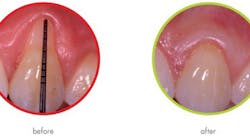From: http://www.straumann.us/en/professionals/products-and-solutions/regeneration-solutions/tissue-regeneration.html Credited to Prof. Zuchelli, Bologna University.
By Amber Auger, RDH, MPH
We don't drive cars with the same engines that we did 20 years ago, and we don't use the same surgical instruments as we did 20 years ago. However, we are using the same protocols to treat periodontal disease.
I am embarrassed to say that I've celebrated a 6 mm pocket reducing to 4 mm during a protocol. Yes, it's exciting to celebrate a patient owning their disease and following our recommendations. However, is that true attachment? We educate our patients daily that we cannot regrow bone levels, yet we celebrate a 6 mm infrabony defect shrinking to a 4 mm pocket. What we have achieved is tighter tissues, but, when we expose the radiograph, we will not see new bone.
About Emdogain: Emdogain is a biological product made up of a unique group of active proteins found in nascent tooth development naturally and predictably regenerates lost tooth attachment with no second surgical site required.1 Emdogain has over 16 years of clinical research studies. Multiple comprehensive studies have been conducted by Heden G, and 72 case studies have been released demonstrating the clinical successes of Emdogain use.2
Benefits: This product that can be utilized to treat bony defects, which leads to bone regrowth.
Indications for use: Emdogain is used to help regenerate bone, as well as regeneration of clinical attachment. Emdogains’ proteins work quickly to rebuild the lost bone and clinical attachment levels.
This means Emdogain provides true regeneration of the underlying support structures for the gingiva. Now, that's something to celebrate.
References
- Straumann. About Emdogain. 2010. Available at: http://www.straumann.us/en/home/recession/about-emdogain.html. Accessed January 16, 2016.
- Heden G. Department of Periodontology, Public Dental Service, Alvgatan 47, 652 30 Karlstad, Sweden. The International Journal of Periodontics & Restorative Dentistry. 2000, 20 (2): 127-139.







